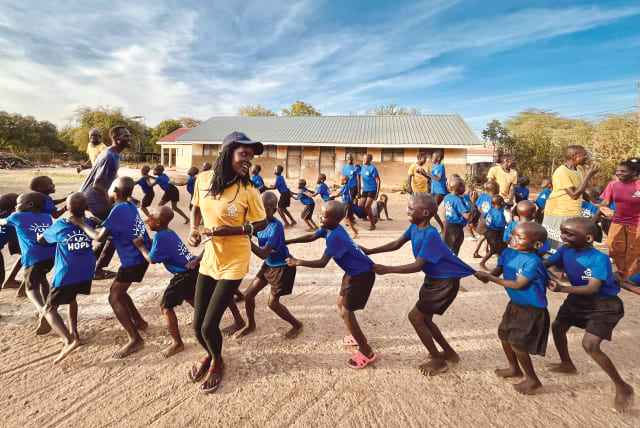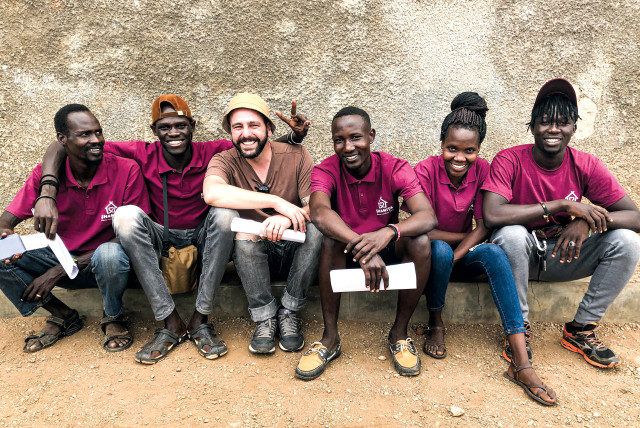Shanita: An Israel NGO helping children in Uganda

How Israeli photo-journalist Lior Sperandeo moved from behind the camera to effecting change in East Africa.
To go to school, a child in Karamoja, northeastern Uganda, must present a bag of sugar, a small broom, shoes, and school uniforms, Shanita founder Lior Sperandeo told The Jerusalem Report. The sugar is used for the morning porridge children eat. Due to ever-prolonged droughts, Karamoja and other regions of East Africa suffer from food shortages. This means students, and the adults around them, often suffer from hunger as they try to hold classes and study a subject such as English. Shanita is an Israeli organization that helps children in Uganda attain educational opportunities.
Sperandeo is a self-taught photo-journalist who climbed up the news corporation ladder, from the person schlepping cables to the eye behind the camera. The Christian news channel he worked for made him an offer: create documentaries about how Israeli NGOs function during humanitarian crises.
He found himself with Israeli activists in hot spots around the world, from the 2015 Gorkha earthquake in Nepal to the refugee crisis on the Greek island of Lesvos, where thousands currently live in transit camps waiting for their appeal to be processed.
“It was in Lesvos that I began to feel an inner conflict,” Sperandeo said. “A boat full of people hits the shore. Some of the people in it are busy hauling out water so they won’t sink. Other people are destroying the boat so nobody could order them to leave on it. Some look up, what do they see? An army of photographers and reporters rushing towards them.”
“It was then,” he said, “I began to feel I don’t want to tell the story of the Westerner who came for a two-week volunteering stint, I want to tell the story of the real hero. The person who is living this crisis and is collecting the fragments of her life with bare hands.”
In the 2010 film The Bang Bang Club, an angry Black South African man tells a white photographer (Ryan Phillippe), “This is a white man’s photo taken for white man’s purposes.”
The film is a drama-filled attempt to share the real histories of conflict reporters. Among them are Greg Marinovich (whom Phillippe plays) and Kevin Carter.
Carter took the famous 1993 photograph from the Sudan famine which depicted a starving child and a vulture in the background. Published by The New York Times, it earned Carter a Pulitzer Prize. Having witnessed many horrors, Carter took his own life in 1994.
Photographers: Documenting crises worldwide
Photographers, Sperandeo said, often form personal relationships with the people they take pictures of and return to conflict zones to report back on what, if anything, has changed.
Sperandeo used to bring his contacts the printed photographs from his last visit. They were usually very happy to see these pictures, but every so often they would become sad because right there was a picture of a child who died.
When he asked why the child died, they said the cause was malaria, which can be treated if one has access to Western medicine.
“This built inside of me a sort of contempt for the pornography of poverty,” he said. “This Hallel-like prayer honoring aid agencies. I wanted to be on the side of the actual heroes.”
It was in Karamoja that the Israeli photographer met Mukatabara, who asked him to help his daughter, Shanita, to go to school.
Sperandeo had some spare money after buying an entry visa to Uganda, and gave it to him.
When he returned to Karamoja, he wondered what happened to that child and went to check.
Her father had taken the money and bought a goat. Shanita never saw the inside of a classroom.
In Dead Aid, a 2010 book by Dambisa Moyo that Sperandeo often referred to during the interview, this dynamic is explained.
Mukatabara wants his daughter to go to school, but he also has a family to feed. Buying a goat, which can offer milk over a long time, is a much more sensible choice than sending Shanita to school. It is this gap between what Westerners expect aid recipients to do and what is actually done with the aid that often leads to clashes.
“Aid agencies offer people condoms, for example, or mosquito nets,” Sperandeo said. “The children take these condoms and blow them up and modify them to have makeshift soccer balls to play with. Or their parents take the nets and turn them into ropes to tie their roofs.”
The aid workers look around with pleasure. All the items had been taken, ergo the goal of sex education or preventing malaria had been reached. Time to secure more funding to get more items!
However, in the lived reality of these societies, African factories that made mosquito nets went out of business because nobody would buy an item that is given for free. So jobs were lost, and now malaria-preventing nets are not available because they were turned into ropes.
Sperandeo described how in one case, an aid agency built a water tower, hoping to offer people clean drinking water. Not realizing that in a herding culture, a free source of water would lead to people building a camp. The camp would lead to human waste production. Without toilets, the water would become polluted and unsafe to drink. Which is exactly what happened.
“This is why I moved to Karamoja,” he explained, “to be a part of the community and really understand how they do things. At the time, the person who translated for me was embarrassed over what Mukatabara has done and began chiding him for cheating me. I understood that money by itself would not solve anything.”
Sperandeo decided to do things differently. He went around Karamoja collecting the needed items – bags of sugar, brooms and the like. Then he went to a school and got the papers needed to enroll Shanita.
He then returned to Mukatabara and his wife and told them: ‘I have done everything. If you send her to school, we will be partners in this project and she could study. I cannot do it for you.’
Shanita is now finishing her third year of school and is able to speak English.
This in a part of Uganda where 38% of girls never go to high school and one quarter are wed before they reach adulthood for bridal money, US Aid reported in 2016.
The Karamojong people, he explained, are herders who are deeply connected to the land they live on. “They are full of resilience,” he pointed out. “They might be poor by Western standards, but they don’t throw away food or produce a lot of waste. When asked what we can give them, they do not ask for laptops or Western high school kids who will build huts for them – they ask for a gift that never spoils and cannot be taken from them, to teach their children so that they will be able to help themselves.”
Israeli sponsors offer NIS 150 per month and receive regular reports on the progress of the children they help.
Right now, there are twenty such children. Fifty more are on the waiting list for the next school year to open.
When sponsors visit in person, Sperandeo said, they often feel they should have done more.
“I have three laptops at home I am not using,” a sponsor might say. “Why didn’t you ask for one? I would have given it to you.”
The urgency, and the realization of how little is needed to change the trajectory of a human life, is a little like the famous scene in the film Schindler’s List where Liam Neeson (as Oskar Schindler) realizes he could have sold his watch and saved one more person.
“Every reader who contacts us,” Sperandeo said, “will save a life.” ■
Visit https://en.shanita.org/ to learn more about Shanita.
Jerusalem Post Store
`; document.getElementById("linkPremium").innerHTML = cont; var divWithLink = document.getElementById("premium-link"); if (divWithLink !== null && divWithLink !== 'undefined') { divWithLink.style.border = "solid 1px #cb0f3e"; divWithLink.style.textAlign = "center"; divWithLink.style.marginBottom = "15px"; divWithLink.style.marginTop = "15px"; divWithLink.style.width = "100%"; divWithLink.style.backgroundColor = "#122952"; divWithLink.style.color = "#ffffff"; divWithLink.style.lineHeight = "1.5"; } } (function (v, i) { });

